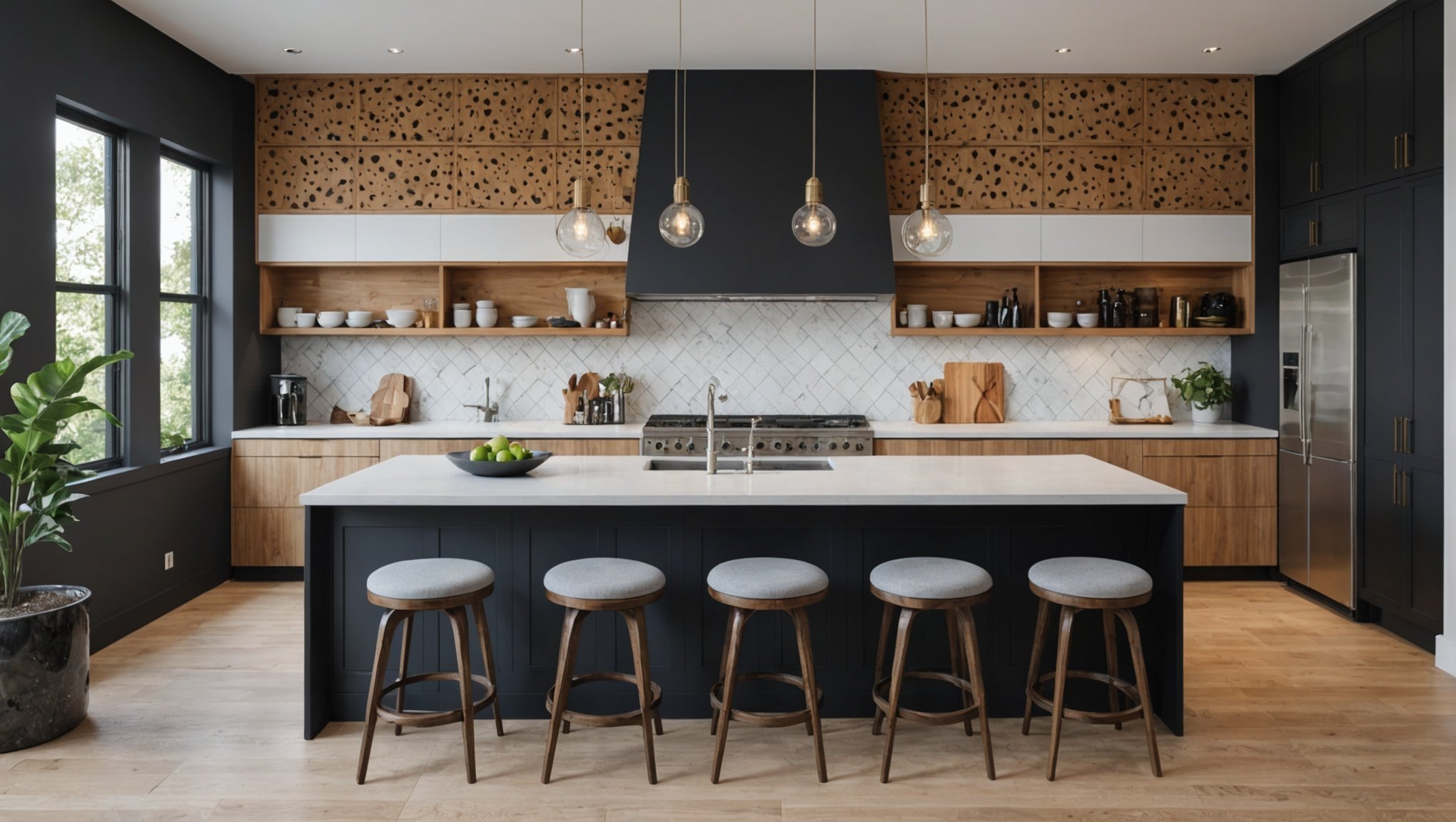Transforming your kitchen into a chic sanctuary involves more than aesthetics; it’s also about creating a comfortable sound environment. Acoustic panels offer an innovative solution to reduce noise while enhancing visual appeal. From bold colors to elegant textures, these decorative elements can seamlessly blend with your kitchen’s style. Explore creative ways to integrate acoustic panels, allowing you to enjoy your culinary space without compromising on beauty or functionality. Discover how this thoughtful addition can elevate your kitchen experience.
Design Inspiration for Acoustic Panels in Kitchen Spaces
In the realm of interior design trends, kitchen acoustics have become a focal point. As kitchens evolve into multi-functional spaces, the demand for effective acoustic solutions is rising. Acoustic panel design plays a crucial role in enhancing both the aesthetic and auditory experience of these spaces.
In parallel : Unlocking Natural Light: The Impact of Your Home”s Orientation on Kitchen Illumination
Current trends highlight the integration of acoustic panels that not only serve a functional purpose but also complement the overall design. For instance, panels with geometric patterns or natural textures are popular choices, adding an artistic flair while improving sound quality. These designs cater to the growing desire for kitchens that are both beautiful and practical.
Visual examples abound, showcasing how kitchen acoustics can be seamlessly incorporated into various styles. From minimalist setups with sleek, monochrome panels to rustic kitchens featuring wooden acoustic elements, the possibilities are vast.
This might interest you : Unlocking Kitchen Safety: Harnessing IoT Devices for a Safer Culinary Experience
Case studies further illuminate the success of these implementations. In one example, a modern kitchen utilized bright, colorful panels to create a lively atmosphere while effectively managing noise levels. Another case saw a traditional kitchen benefit from subtle, fabric-covered panels that blended with the decor, enhancing the space without overwhelming it.
These examples and trends underscore the potential of acoustic panels to transform kitchen spaces into harmonious environments.
Benefits of Acoustic Panels in Kitchen Environments
Acoustic panels offer significant benefits in kitchen environments, primarily through sound absorption. These panels are designed to capture and dampen sound waves, which reduces echo and reverberation. By improving sound quality, they create a more pleasant and functional space. This is particularly important in kitchens, where noise from appliances and conversations often overlaps, leading to a chaotic atmosphere.
The impact of noise reduction on kitchen functionality cannot be overstated. A quieter kitchen allows for easier communication, whether you’re hosting a gathering or simply enjoying a meal with family. Acoustic panels contribute to a serene environment, making it easier to focus on cooking or entertaining without the distraction of excessive noise.
Furthermore, the overall enhancement of kitchen ambiance is a notable benefit. By integrating acoustic panels, the kitchen becomes not only a place for culinary activities but also a comfortable space for relaxation and socialising. The panels can be customised to match the kitchen’s decor, adding an aesthetic element that complements their functional purpose. With these improvements, acoustic panels transform kitchens into harmonious environments that cater to both practical and aesthetic needs.
Selecting the Right Acoustic Panels for Your Kitchen
Choosing the appropriate acoustic panel selection for your kitchen involves considering various factors, including material choices and aesthetic compatibility. Acoustic panels come in a range of materials such as fabric, wood, and foam, each offering distinct acoustic properties. Fabric panels are versatile and can be customised to match any kitchen decor, while wooden panels add a natural touch and are ideal for rustic settings. Foam panels, known for their excellent sound absorption, are perfect for minimalist designs.
When selecting panels, consider their aesthetic compatibility with your kitchen decor. Panels should complement the existing colours and textures to create a cohesive look. For a modern kitchen, sleek, monochrome panels may be suitable, whereas traditional kitchens might benefit from panels with intricate patterns or warm tones.
The size and placement of acoustic panels are crucial for optimal sound management. For effective noise reduction, place panels on walls opposite to noise sources, such as appliances or dining areas. In smaller kitchens, smaller panels strategically placed can achieve the desired effect without overwhelming the space. Conversely, larger kitchens may require a combination of panel sizes to ensure comprehensive coverage and maintain aesthetic harmony.
DIY Acoustic Panel Projects for Kitchen Renovation
Embarking on a DIY acoustic panel project can be a rewarding home improvement endeavour, offering budget-friendly solutions to enhance your kitchen acoustics. Here’s a step-by-step guide to help you create your own panels.
Step-by-Step Guide
- Gather Materials and Tools: You’ll need fabric, a wooden frame, acoustic foam, a staple gun, and scissors. These materials are readily available at most hardware or craft stores.
- Construct the Frame: Cut wooden pieces to size and assemble them into a rectangular frame. Ensure the frame is sturdy enough to hold the foam and fabric.
- Attach Acoustic Foam: Cut the foam to fit within the frame and secure it using the staple gun. This step is crucial for effective sound absorption.
- Cover with Fabric: Choose a fabric that complements your kitchen style. Stretch the fabric over the frame and staple it securely at the back. This not only enhances aesthetics but also protects the foam.
Tips for Customization
- Colour and Pattern: Opt for colours and patterns that align with your kitchen’s decor.
- Size and Shape: Experiment with different sizes and shapes to fit your space.
- Personal Touch: Add embellishments like buttons or trims for a unique look.
These home improvement projects allow for creative expression while improving kitchen acoustics.
Installation Techniques for Acoustic Panels
Installing acoustic panels in your kitchen can significantly enhance your space’s sound quality and aesthetics. Understanding the various acoustic panel installation methods is crucial before you begin.
DIY Installation Tips
For those opting for a DIY approach, start by choosing the right tools: a drill, level, and measuring tape are essentials. Ensure you measure the wall space accurately to avoid misalignment. When attaching panels, use appropriate wall anchors to secure them firmly, especially for heavier materials like wood.
Common Mistakes to Avoid:
- Misjudging panel placement: Ensure panels are installed opposite noise sources for maximum effectiveness.
- Overlooking wall texture: Uneven surfaces can affect panel adhesion and alignment.
Professional Installation
While DIY methods can be rewarding, there are scenarios where professional installation is advisable. Consider hiring an expert if:
- Your kitchen has complex architectural features.
- You’re using high-end or delicate materials that require specialized handling.
- You want to ensure optimal placement for sound management.
Professionals bring expertise that can prevent costly errors and ensure your panels are both functional and aesthetically pleasing. Whether you choose DIY or professional installation, the key is to plan thoroughly and execute with precision.
Before-and-After: Transforming Kitchens with Acoustic Panels
The transformation of kitchens with acoustic panels is a testament to their dual role in enhancing both aesthetics and functionality. Through a series of compelling before-and-after images, the impact of these panels becomes evident. Kitchens once plagued by excessive noise and bland designs now exude a sense of calm and style.
Visual Case Studies
- Modern Elegance: A contemporary kitchen, initially stark and echo-prone, was revitalised with sleek, monochrome panels. These additions not only absorbed unwanted sound but also introduced a clean, sophisticated look that harmonised with the kitchen’s minimalist theme.
- Rustic Charm: In a traditional setting, wooden acoustic panels transformed a once noisy and cluttered space into a serene retreat. The panels’ natural textures complemented the rustic decor, enhancing both visual appeal and acoustic comfort.
Homeowner Testimonials
Homeowners frequently express satisfaction with their kitchen transformation. One user noted, “The acoustic panels have made my kitchen a peaceful haven. Conversations are clearer, and the design is stunning.” Another mentioned the panels’ dual benefits, saying, “Not only do they look great, but they also significantly reduce noise. It’s like having a brand-new kitchen.”
Expert Opinions on Acoustic Panels in Kitchen Design
In the world of kitchen design, expert insights from interior designers and acoustics specialists are invaluable. These professionals provide a wealth of interior design advice on the strategic use of acoustic panels. Interviews with leading interior designers reveal that acoustic panels are increasingly seen as essential elements in modern kitchens. They highlight the importance of integrating these panels seamlessly into the overall design to enhance both aesthetics and functionality.
Acoustic panel specialists emphasize the panels’ effectiveness in managing sound, noting how they significantly reduce noise levels and improve the auditory experience. They advise that selecting the right materials and placement is crucial for maximizing these benefits. For instance, panels made from dense materials like wood or specialized foams are recommended for their superior sound absorption properties.
Looking to the future, experts predict that kitchen acoustics will continue to evolve, with trends leaning towards more personalized and adaptable solutions. The integration of smart technology into acoustic panels is anticipated, offering homeowners greater control over their kitchen environments. As the demand for multi-functional kitchen spaces grows, the role of acoustic panels in design will undoubtedly expand, making expert insights more valuable than ever.
Maintaining and Caring for Acoustic Panels
Proper acoustic panel maintenance is essential to ensure their longevity and effectiveness. Different materials require specific cleaning methods. For fabric panels, regular vacuuming with a soft brush attachment prevents dust accumulation. If stains occur, use a mild detergent and gently dab the area with a damp cloth. Wooden panels benefit from dusting with a microfiber cloth and occasional polishing with a wood-friendly product. Foam panels require careful handling; a light vacuuming is usually sufficient.
To extend the lifespan of your panels, consider these care tips:
- Regular Inspection: Check for any signs of wear or damage. Addressing issues promptly prevents further deterioration.
- Avoid Moisture: Keep panels away from high humidity areas to prevent warping or mold growth.
- Secure Mounting: Ensure panels are firmly attached to avoid accidental falls or misalignment.
Common issues such as decreased acoustic performance can often be traced back to dust build-up or improper installation. Ensuring panels are clean and correctly positioned will maintain their sound-absorbing capabilities. By following these guidelines, your acoustic panels will continue to enhance your kitchen’s ambiance and functionality for years to come.






